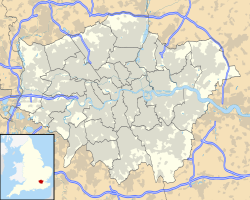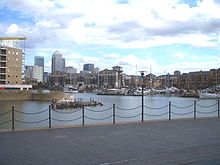Limehouse Basin (Regent's Canal)
Location of the Limehouse Basin in Greater London |
The Limehouse Basin in Limehouse in the London Borough of Tower Hamlets forms the navigable link between Regent's Canal and the Thames . A lock mediates the transition from the Limehouse Basin to the river. A canal basin north of Mile End near Victoria Park connects to the Hertford Union Canal , which leads to the Lea . The harbor basin originally covered an area of 60,703 m². It is located between the Docklands Light Railway (DLR) route and the historic Narrow Street. Directly to the east there is a small park, Ropemaker's Fields .
history
The basin, which was built by the Regent's Canal Company , was formerly called Regent's Canal Dock and was used by ocean-going vessels and barges to reload goods into canal barges, which then transported them along Regent's Canal. Immediately after opening in 1820, the harbor basin and the canal were not a great success, but in the middle of the 19th century, the coal supply of the many gas works and later also the power stations for electricity, as well as for many private and commercial purposes, brought enormous economic benefits Boom for the waterway. At that time the Limehouse Basin was the main entrance to the British canal system. With the introduction of the railroad, its importance declined, even if the revival of the canal traffic during the First and Second World Wars was a brief swan song.
The Docklands Light Railway runs on a viaduct that originally ran for the London and Blackwall Railway above the original landing stages on the north side of the basin. Below is the Commercial Road Lock , a lock that leads to Regent's Canal.
East of the canal entrance behind the arch of the viaduct is the octagonal tower of a hydraulic accumulator (1869), which replaced an older first building from the 1850s, which was built by William G. Armstrong , engineer and inventor. This regulated the hydraulic pressure of the extensive network of hydraulic lines that supplied the machines for unloading the coal around the basin. The associated steam generators and hydraulic pumps were dismantled. The building was converted by Dransfield Owens de Silva for the purposes of the London Docklands Development Corporation (LDDC) so that it served as a viewing platform. These buildings and the basin now belong to the British Waterways and belong to the Grade II listed protected buildings and are open every year for the Open House Weekend , usually the 3rd weekend in September.
The history of the connection of the Basin to the Thames and the Limehouse Cut is very complex, but in 1968 a short new section of canal was built which reconnected the Limehouse Cut to the Basin and replaced the old connection of the Limehouse Cut with the Thames. It was closed to merchant shipping in 1969, with a wharf in the basin for recreational boats being retained.
Urban development
Urban development around the Basin began in 1983 as part of the LDDC's master plan for the Docklands area . However, it took many years before it was realized. The real estate boom and its collapse in the 1980s set plans far back, as did the construction of the Limehouse Link Tunnel , which was built under the northern half of the basin in the early 1990s. In early 2004, most of the former industrial wasteland around the Limehouse Basin was converted into luxury apartments.
Many of the apartments around the basin were built by Belway Homes . The development took place in several sections. One of the first sections was Limehouse West , a complex with 262 apartments: Medland House (2 buildings - blocks A1 / A2 and A3), Berglen Court (3 buildings - blocks B1, B2 / B3 and B4 / B5) and Pinnacle (1 building - Block B6). The last section consisted of three apartment blocks (Pinnacle II); Block E, 9 three-story townhouses on two terraces of 6 and 3 houses; Block F, a five-story apartment building.
Life around the Limehouse Basin
In addition to the apartment blocks around the Limehouse Basin, there are a number of other facilities.
The Cruising Association has its headquarters in the Limehouse Basin and the Master Ding Academy, a tai chi center , opened in March 2005 in a shop on Berglen Court. Further down Narrow Street there are many pubs including The Narrow (run by Gordon Ramsay ) and The Grapes , a historic old style pub.
The Mosaic shopping center is located south of the basin . There are many shops there, such as La Figa (an Italian restaurant), Verde (an Italian delicatessen and café) and a dry cleaner.
Further development
Bellway Homes recently completed the Zenith on the west side of the basin. Four shopping centers are still free, especially due to the lack of delivery routes. Work is currently underway to expand DLR's Limehouse station to accommodate trains with 3 cars. The station will be expanded across Branch Road and a link will be created under the bridge near the new building at the west end.
First Base is due to hold a presentation of its plans for the site over the basin on Branch Road in late 2008.
Web links
Individual evidence
- ^ First Base property developers . First base. May 15, 2008 ( Memento of the original from April 21, 2008 in the Internet Archive ) Info: The archive link has been inserted automatically and has not yet been checked. Please check the original and archive link according to the instructions and then remove this notice.



